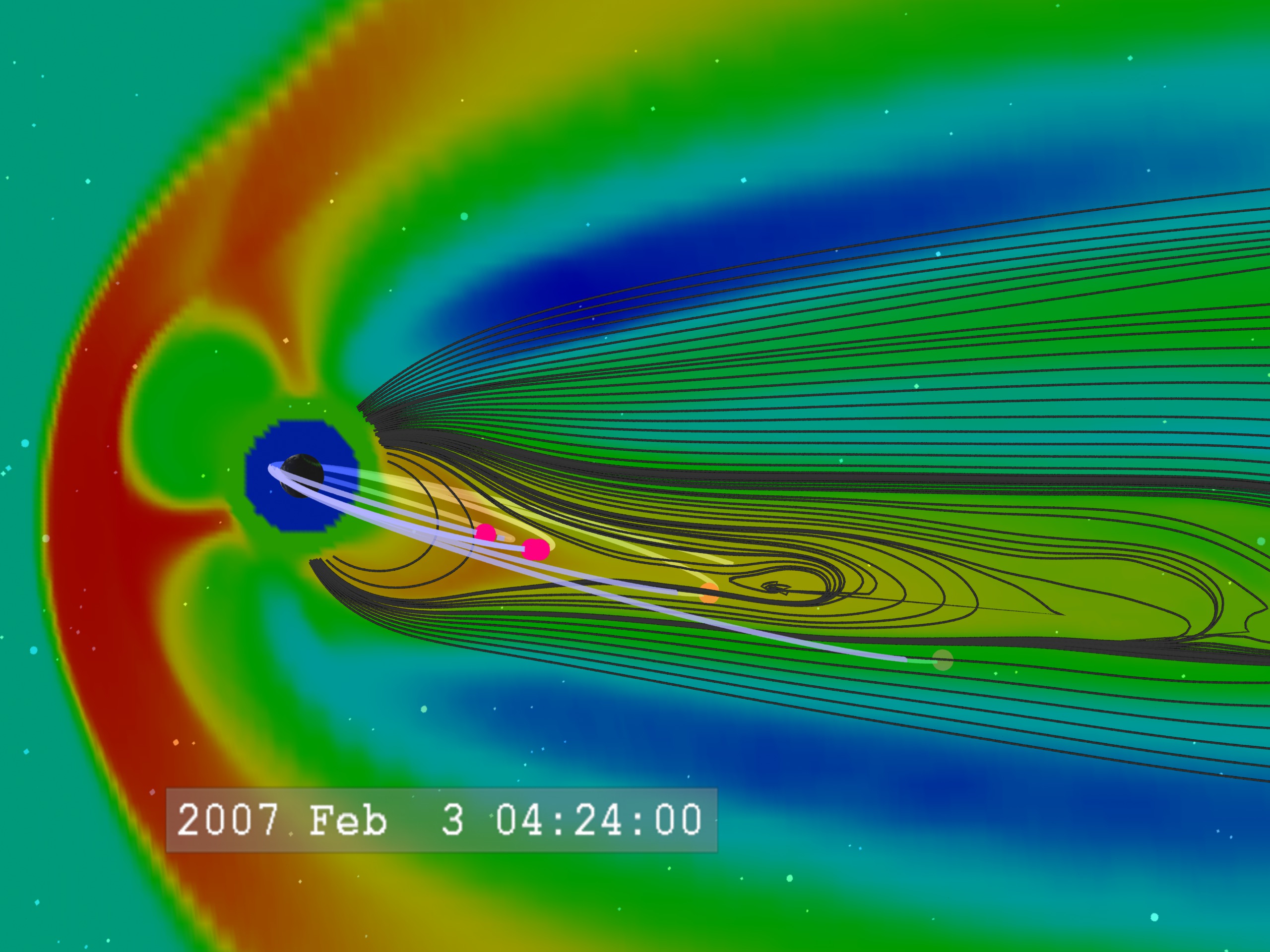Sun
ID: 3356
This visualization combines simulations of the THEMIS (Time History of Events and Macroscale Interactions during Substorms) mission orbits with a GGCM (Geospace General Circulation Model) simulation. It illustrates how the five THEMIS satellites will work together to detect substorm events in the magnetosphere. One goal of the THEMIS mission is to test how these substorm events are related to the formation of the aurora.
This mission consists of five identical spacecraft (usually designated P1, P2, P3, P4 and P5) with orbits aligned so they reach their apogee along the same line from the Earth. This alignment remains fixed in space so as the Earth moves around the Sun, the constellation of spacecraft will extend on the nightside of the Earth in winter to sample the Earth's magnetosphere, and on the dayside of the Earth in summer to sample the incoming solar wind. This way they can better map the geospace environment.
Probes P1 and P2 are called the 'outer probes' and P3, 4, and 5 are the 'inner probes'. P3 and P4 share the same orbit. The outer probes will detect the onset of the substorm, while the inner probes will monitor the Earthward plasma flows from the event.
For more information on the GGCM model, visit the Community Coordinated Modeling Center and OpenGGCM.








THEMIS Mission and Substorm Simulation
This mission consists of five identical spacecraft (usually designated P1, P2, P3, P4 and P5) with orbits aligned so they reach their apogee along the same line from the Earth. This alignment remains fixed in space so as the Earth moves around the Sun, the constellation of spacecraft will extend on the nightside of the Earth in winter to sample the Earth's magnetosphere, and on the dayside of the Earth in summer to sample the incoming solar wind. This way they can better map the geospace environment.
Probes P1 and P2 are called the 'outer probes' and P3, 4, and 5 are the 'inner probes'. P3 and P4 share the same orbit. The outer probes will detect the onset of the substorm, while the inner probes will monitor the Earthward plasma flows from the event.
For more information on the GGCM model, visit the Community Coordinated Modeling Center and OpenGGCM.








Visualization Credits
Tom Bridgman (Global Science and Technology, Inc.): Lead Animator
Vassilis Angelopoulos (University of California at Berkeley): Scientist
David G. Sibeck (NASA/GSFC): Scientist
Joachim Raeder (University of New Hampshire): Scientist
Vassilis Angelopoulos (University of California at Berkeley): Scientist
David G. Sibeck (NASA/GSFC): Scientist
Joachim Raeder (University of New Hampshire): Scientist
Please give credit for this item to:
NASA/Goddard Space Flight Center Scientific Visualization Studio
Additional Credits: Tom Fogal (University of New Hampshire) for assistance with the GGCM data extraction software. Sabine Frey (UC Berkeley) for spacecraft orbit information.
NASA/Goddard Space Flight Center Scientific Visualization Studio
Additional Credits: Tom Fogal (University of New Hampshire) for assistance with the GGCM data extraction software. Sabine Frey (UC Berkeley) for spacecraft orbit information.
Short URL to share this page:
https://svs.gsfc.nasa.gov/3356
Mission:
THEMIS
Data Used:
Note: While we identify the data sets used in these visualizations, we do not store any further details nor the data sets themselves on our site.
This item is part of this series:
THEMIS Pre-launch
Keywords:
SVS >> Geomagnetic Field
SVS >> HDTV
SVS >> Magnetic Fields
SVS >> Magnetic Reconnection
SVS >> Magnetosphere
SVS >> Plasma
DLESE >> Space science
GCMD >> Earth Science >> Sun-earth Interactions >> Ionosphere/Magnetosphere Particles >> Aurorae
GCMD >> Earth Science >> Sun-earth Interactions >> Ionosphere/Magnetosphere Particles >> Energetic Particles
GCMD >> Earth Science >> Sun-earth Interactions >> Ionosphere/Magnetosphere Particles >> Particle Density
GCMD >> Location >> Magnetotail
SVS >> Space Weather
SVS >> THEMIS
NASA Science >> Sun
GCMD >> Earth Science >> Sun-earth Interactions >> Ionosphere/Magnetosphere Dynamics >> Aurorae
GCMD keywords can be found on the Internet with the following citation: Olsen, L.M., G. Major, K. Shein, J. Scialdone, S. Ritz, T. Stevens, M. Morahan, A. Aleman, R. Vogel, S. Leicester, H. Weir, M. Meaux, S. Grebas, C.Solomon, M. Holland, T. Northcutt, R. A. Restrepo, R. Bilodeau, 2013. NASA/Global Change Master Directory (GCMD) Earth Science Keywords. Version 8.0.0.0.0
https://svs.gsfc.nasa.gov/3356
Mission:
THEMIS
Data Used:
THEMIS
2007-02-01T00:00:00 - 2007-02-03T07:00:00SSCweb also referred to as: SSCweb ephemerides
Ephemeris - NASA/GSFC Space Physics Data Facility - 2007-02-01T00:00:00 - 2007-02-03T07:00:00
Satellite ephemerides
Geospace General Circulation Model (GGCM) also referred to as: GGCM
Model - University of New Hampshire - 2007-02-01T00:00:00 - 2007-02-03T07:00:00
MHD Magnetospheric simulation
This item is part of this series:
THEMIS Pre-launch
Keywords:
SVS >> Geomagnetic Field
SVS >> HDTV
SVS >> Magnetic Fields
SVS >> Magnetic Reconnection
SVS >> Magnetosphere
SVS >> Plasma
DLESE >> Space science
GCMD >> Earth Science >> Sun-earth Interactions >> Ionosphere/Magnetosphere Particles >> Aurorae
GCMD >> Earth Science >> Sun-earth Interactions >> Ionosphere/Magnetosphere Particles >> Energetic Particles
GCMD >> Earth Science >> Sun-earth Interactions >> Ionosphere/Magnetosphere Particles >> Particle Density
GCMD >> Location >> Magnetotail
SVS >> Space Weather
SVS >> THEMIS
NASA Science >> Sun
GCMD >> Earth Science >> Sun-earth Interactions >> Ionosphere/Magnetosphere Dynamics >> Aurorae
GCMD keywords can be found on the Internet with the following citation: Olsen, L.M., G. Major, K. Shein, J. Scialdone, S. Ritz, T. Stevens, M. Morahan, A. Aleman, R. Vogel, S. Leicester, H. Weir, M. Meaux, S. Grebas, C.Solomon, M. Holland, T. Northcutt, R. A. Restrepo, R. Bilodeau, 2013. NASA/Global Change Master Directory (GCMD) Earth Science Keywords. Version 8.0.0.0.0











